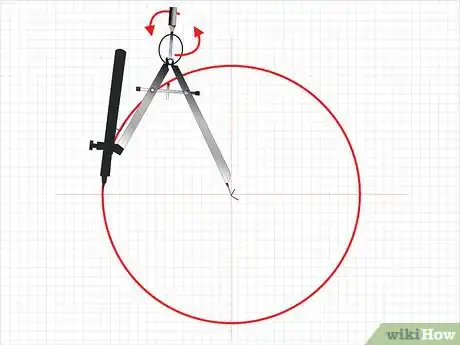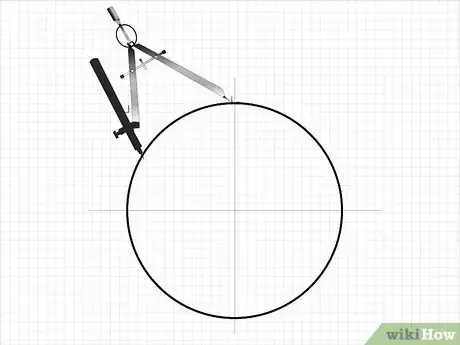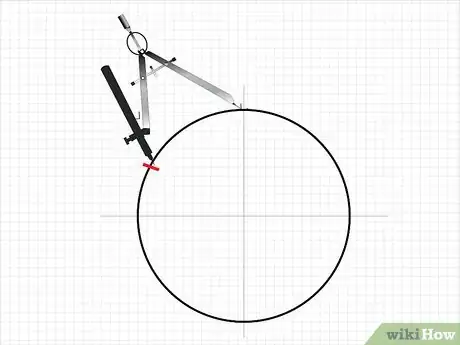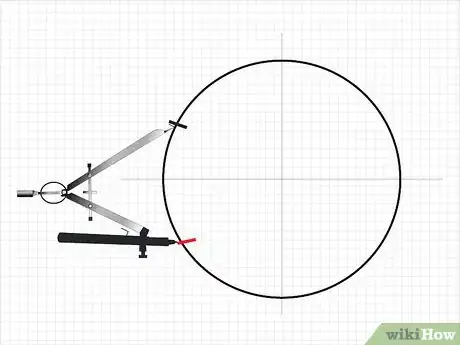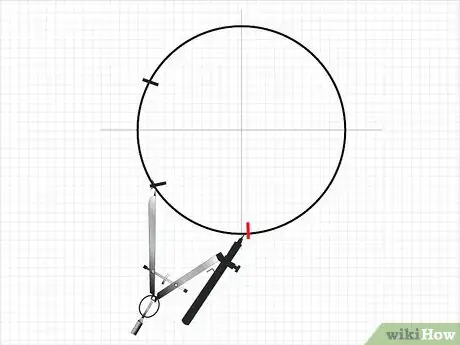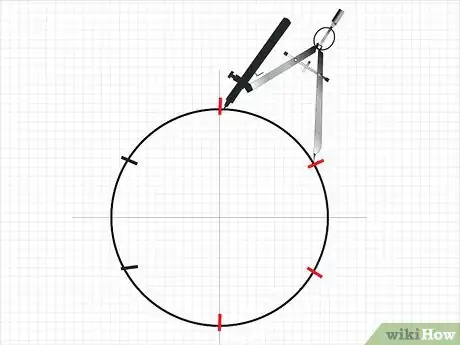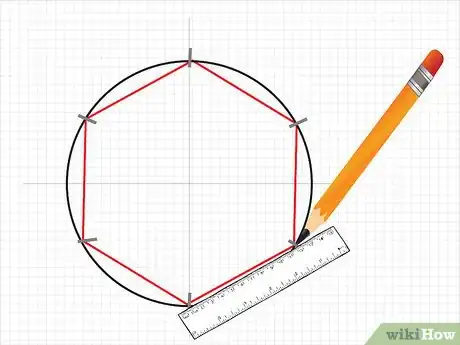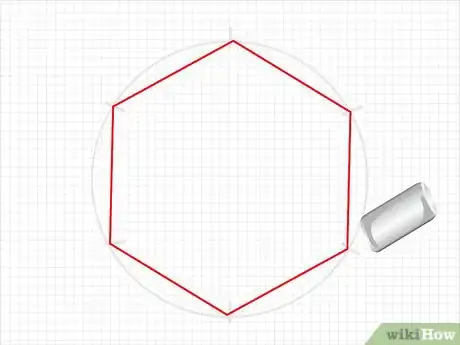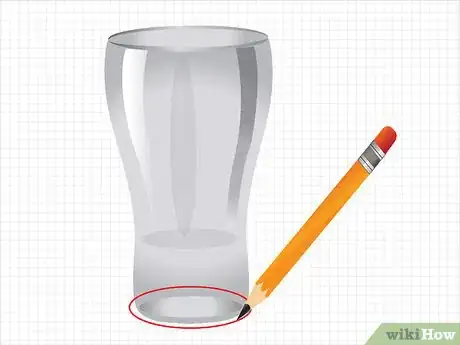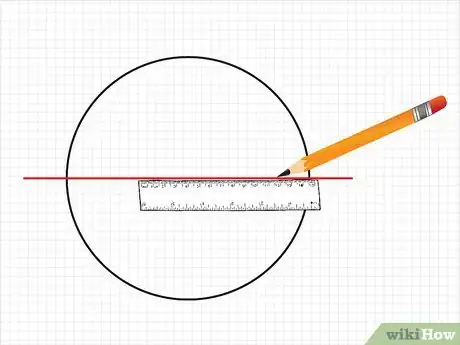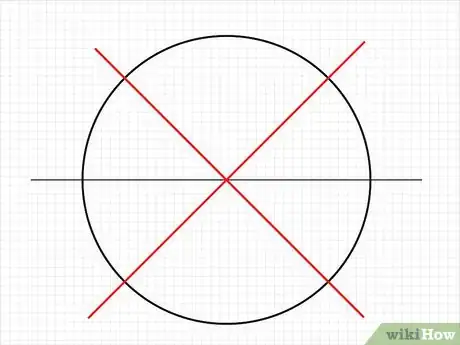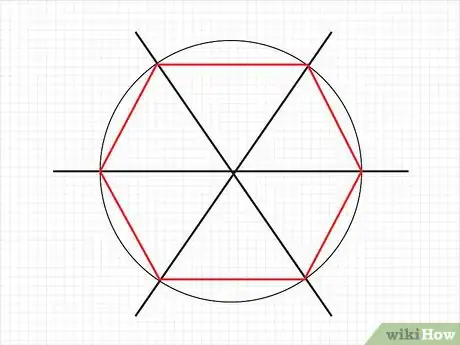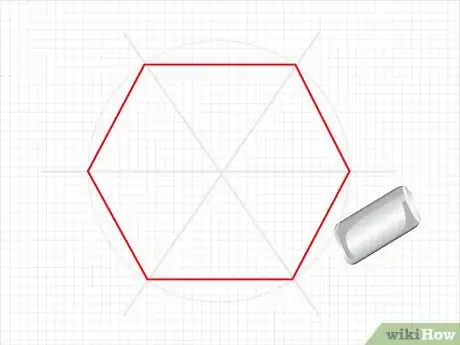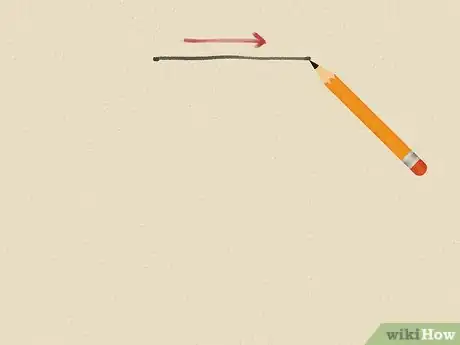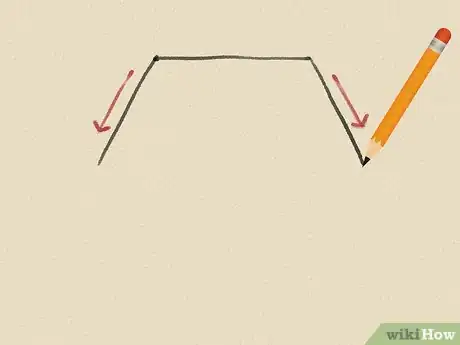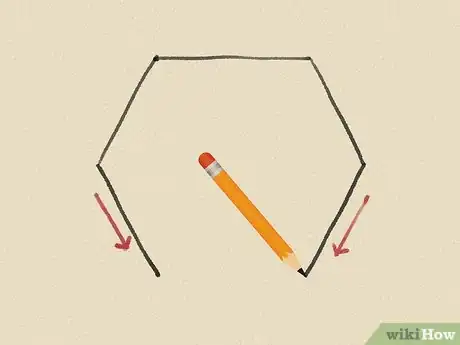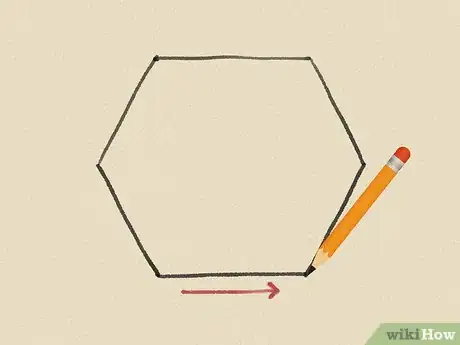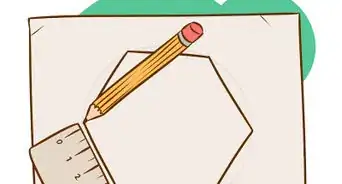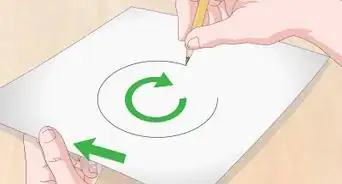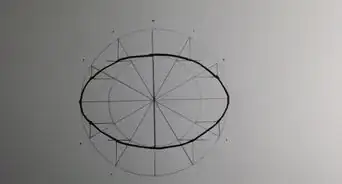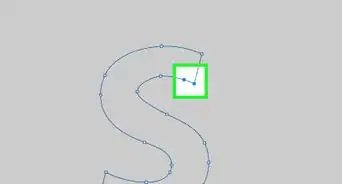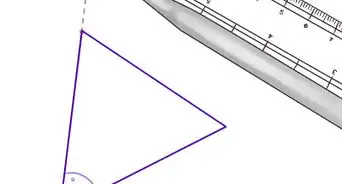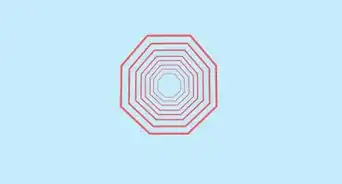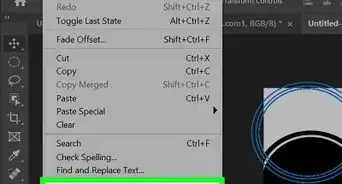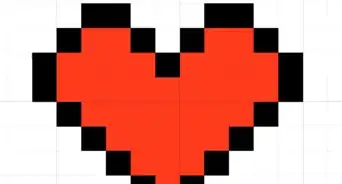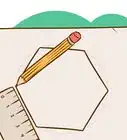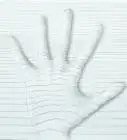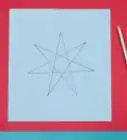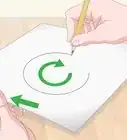This article was co-authored by Kelly Medford. Kelly Medford is an American painter based in Rome, Italy. She studied classical painting, drawing and printmaking both in the U.S. and in Italy. She works primarily en plein air on the streets of Rome, and also travels for private international collectors on commission. She founded Sketching Rome Tours in 2012 where she teaches sketchbook journaling to visitors of Rome. Kelly is a graduate of the Florence Academy of Art.
This article has been viewed 1,235,694 times.
Loosely-defined, a hexagon is any polygon with six sides, but a regular hexagon features six equal sides and six equal angles. Look at pictures of hexagons to get a better idea of what you're drawing. In a pinch, consider simply tracing an existing picture of a hexagon. Use a ruler and a protractor to draw a perfect hexagon. For a rougher hexagon, try using a round shape and a ruler to guide your hand. If precision is not paramount, then feel free to sketch out a simple hexagon using only a pencil and a creative mind.
Steps
Drawing a Perfect Hexagon Using a Compass
-
1Draw a circle with a compass. Place a pencil in your compass. Widen the compass to an appropriate width for the radius of your circle. It can be just a few inches or centimeters wide. Next, place the point of the compass on the paper and sweep the compass around until you've created a circle.
- Sometimes it's easier to draw a half-circle in one direction, and then to come back and draw another half-circle in the other direction.
-
2Move the compass point to the edge of the circle. Move it towards the top of the circle. Do not change the angle or settings of the compass.Advertisement
-
3Make a small mark on the edge of the circle with the pencil. Make it distinct, but not too dark -- you'll be erasing it later. Remember to maintain the angle you've set for the compass.
-
4Move the compass point to the mark you made. Place the point right on the mark.
-
5Make another mark on the edge of the circle with a pencil. This should create a second mark a distance away from the first mark. If you’ve been moving clockwise or counterclockwise around the circle, continue to do so.
-
6Make the last four marks using the same method. You should end up back at the mark where you originally started. If you don’t, it’s likely that the angle of your compass changed while you worked, possibly from squeezing it too firmly or letting it loosen a bit.
-
7Connect the dots with a ruler. The six places where your marks cross the edge of the circle are the six points of your hexagon. Use your ruler and a pencil to draw a straight line segment that connects the adjacent dots.
-
8Erase your guiding lines. These include your original circle, the marks along the edges, and any other marks you made along the way. Once you've erased your guiding lines, your perfect hexagon should be complete.
Drawing a Rough Hexagon Using a Round Object and a Ruler
-
1Trace the round rim of a glass with a pencil. This will create a circle. It's important to use a pencil because you'll need to erase the marks you made later. You can also trace the rim of an upside-down mug, a jar or food container, or anything else with a round base.
-
2Draw a horizontal line through the center of your circle. You can use a ruler, book, or any straight edge to do this. If you do have a ruler, you can find the halfway mark by measuring the vertical length of the circle and splitting it in half.
-
3Draw an X over the halved circle, splitting it up into 6 equal sections. Since you already have a line running down the middle of the circle, the X will have to be taller than it is wide to keep the pieces even. Just think of this as slicing a pizza into 6 equal pieces.
-
4Turn each of the six sections into triangles. To do this, simply use a ruler to draw a straight line under the curved part of each section, connecting it to the other two straight lines to form a triangle. Repeat this process six times. You can think of this as forming a "crust" around your pizza slices.
-
5Erase your guiding lines. The guiding lines include the lines in your original circle, the three lines that separate the circle into six sections, and any other marks you made along the way.
Drawing a Rough Hexagon Using Only a Pencil
-
1Draw a horizontal line. To draw a straight line without a ruler, just draw a starting and ending dot for the horizontal line. Then place your pencil on the starting dot and keep your eye on the ending dot as you draw a straight line toward it. This line can be just a few inches or centimeters long.
-
2Draw two diagonal lines from the ends of the horizontal line. The diagonal line on the left side should be opening up toward the left, and the diagonal line on the right side should be opening up toward the right. You can think of each of these lines forming a 120 degree angle with the horizontal line.
-
3Draw two more diagonal lines moving inward from the bottom edges of the first two diagonal lines. They should create a mirror-image of the first two diagonal lines. The line on the bottom left should look like a reflection of the line on the top left, and the line on the bottom right should look like a reflection of the line on the top right. While the top lines were moving outward from the top horizontal line, the bottom lines should move inward from the bottom edges of the top lines, toward the space where the base will be.
-
4Draw another horizontal line connecting the two bottom lines. This will form the base of the hexagon. It should ideally be parallel to the top horizontal line. This will complete your hexagon.
- To improve your artistic skills make drawing fun. Draw whatever makes you happy.
- Doodle, scribble, make shapes on scrap pieces of paper.
- Copy drawings and paintings that you like.
Expert Q&A
-
QuestionWhat is an easy way to scale a drawing?
 Kelly MedfordKelly Medford is an American painter based in Rome, Italy. She studied classical painting, drawing and printmaking both in the U.S. and in Italy. She works primarily en plein air on the streets of Rome, and also travels for private international collectors on commission. She founded Sketching Rome Tours in 2012 where she teaches sketchbook journaling to visitors of Rome. Kelly is a graduate of the Florence Academy of Art.
Kelly MedfordKelly Medford is an American painter based in Rome, Italy. She studied classical painting, drawing and printmaking both in the U.S. and in Italy. She works primarily en plein air on the streets of Rome, and also travels for private international collectors on commission. She founded Sketching Rome Tours in 2012 where she teaches sketchbook journaling to visitors of Rome. Kelly is a graduate of the Florence Academy of Art.
Professional Artist You can buy a small wheel that shows ratios. Use it to scale up the drawing to the same proportions.
You can buy a small wheel that shows ratios. Use it to scale up the drawing to the same proportions. -
QuestionWhy is charcoal suitable for shading?
 Kelly MedfordKelly Medford is an American painter based in Rome, Italy. She studied classical painting, drawing and printmaking both in the U.S. and in Italy. She works primarily en plein air on the streets of Rome, and also travels for private international collectors on commission. She founded Sketching Rome Tours in 2012 where she teaches sketchbook journaling to visitors of Rome. Kelly is a graduate of the Florence Academy of Art.
Kelly MedfordKelly Medford is an American painter based in Rome, Italy. She studied classical painting, drawing and printmaking both in the U.S. and in Italy. She works primarily en plein air on the streets of Rome, and also travels for private international collectors on commission. She founded Sketching Rome Tours in 2012 where she teaches sketchbook journaling to visitors of Rome. Kelly is a graduate of the Florence Academy of Art.
Professional Artist Charcoal is great for shading. It is fast and easy to erase, correct, move around, and work with instead of a pencil.
Charcoal is great for shading. It is fast and easy to erase, correct, move around, and work with instead of a pencil. -
QuestionHow can I figure how wide the sides of a hexagon should be if I know the diameter?
 Community AnswerIf you know the diameter of a circle that touches the corners of the hexagon, this is easy. Halve the diameter to get the length of your hexagon's sides. The reason being, a regular hexagon can be divided into six equilateral triangles by drawing straight lines between opposite corners. These lines are the diameter of the circle that touches the corners of the hexagon, and also twice the length of a triangle side. If you mean you know the diameter of a circle that fits inside the hexagon, then this takes a little more math, but once again cut the number in half. That's the height of one of your equilateral triangles. Knowing that, you can once again calculate the length of the sides.
Community AnswerIf you know the diameter of a circle that touches the corners of the hexagon, this is easy. Halve the diameter to get the length of your hexagon's sides. The reason being, a regular hexagon can be divided into six equilateral triangles by drawing straight lines between opposite corners. These lines are the diameter of the circle that touches the corners of the hexagon, and also twice the length of a triangle side. If you mean you know the diameter of a circle that fits inside the hexagon, then this takes a little more math, but once again cut the number in half. That's the height of one of your equilateral triangles. Knowing that, you can once again calculate the length of the sides.
Warnings
- A compass is a sharp instrument; please handle with care to prevent injury.⧼thumbs_response⧽
Why This Works
- Either method works to create a perfect hexagon by forming 6 equilateral triangles with the radius as the length of all of the sides. The six radii drawn are all of the same length and the six chords drawn to create the hexagon are each the same length as the radius because the compass width was not changed. Because the six triangles are all equilateral, the angles between the vertices are each 60°.
Things You'll Need
- Paper
- Pencil
- Ruler
- A pair of compasses (the kind used for drawing circles is technically referred to as a “pair of compasses” to distinguish it from a navigator's compass, which has a magnetic North/South, etc.) or a glass/mug
- Something to put under the paper so that the compass point doesn't slip
- Eraser
- Protractor
About This Article
To draw a hexagon, start by tracing something round to make a circle. Then, use a ruler to draw a horizontal line through the center of the circle. Next, take the ruler and draw an "x" over the circle so it's divided into 6 equal parts. After you draw the "x," turn each section into a triangle by drawing a straight line between neighboring points along the circle. Finally, erase the circle, the "x," and the horizontal line you drew at the beginning and you'll be left with a hexagon! Keep reading the article if you want to learn how to use a compass to draw a hexagon!
